International Journal of Intelligent Systems and Applications @ijisa
Статьи журнала - International Journal of Intelligent Systems and Applications
Все статьи: 1203
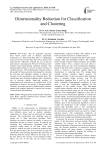
Dimensionality reduction for classification and clustering
Статья научная
Now-a-days, data are generated massively from various sectors such as medical, educational, commercial, etc. Processing these data is a challenging task since the massive data take more time to process and make decision. Therefore, reducing the size of data for processing is a pressing need. The size of the data can be reduced using dimensionality reduction methods. The dimensionality reduction is known as feature selection or variable selection. The dimensionality reduction reduces the number of features present in the dataset by removing the irrelevant and redundant variables to improve the accuracy of the classification and clustering tasks. The classification and clustering techniques play a significant role in decision making. Improving accuracy of classification and clustering is an essential task of the researchers to improve the quality of decision making. Therefore, this paper presents a dimensionality reduction method with wrapper approach to improve the accuracy of classification and clustering.
Бесплатно
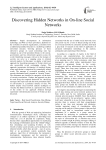
Discovering Hidden Networks in On-line Social Networks
Статья научная
Rapid developments in information technology and Web 2.0 have provided a platform for the evolution of terrorist organizations, extremists from a traditional pyramidal structure to a technology enabled networked structure. Growing presence of these subversive groups on social networking sites has emerged as one of the prominent threats to the society, governments and law enforcement agencies across the world. Identifying messages relevant to the domain of security can serve as a stepping stone in criminal network analysis. In this paper, we deploy a rule based approach for classifying messages in Twitter which can also successfully reveal overlapping clusters. The approach incorporates dictionaries of enriched themes where each theme is categorized by semantically related words. The message is vectorized according to the security dictionaries and is termed as ‘Security Vector’. The documents are classified in categories on the basis of security associations. Further, the approach can also be used along the temporal dimension for classifying messages into topics and rank the most prominent topics of conversation at a particular instance of time. We further employ social network analysis techniques to visualize the hidden network at a particular time. Some of the results of our approach obtained through experiment with information network of Twitter are also discussed.
Бесплатно

Discrete Wavelet Transform and Cross Bilateral Filter based Image Fusion
Статья научная
The main objective of image fusion is to obtain an enhanced image with more relevant information by integrating complimentary information from two source images. In this paper, a novel image fusion algorithm based on discrete wavelet transform (DWT) and cross bilateral filter (CBF) is proposed. In the proposed framework, source images are decomposed into low and high frequency subbands using DWT. The low frequency subbands of the transformed images are combined using pixel averaging method. Meanwhile, the high frequency subbands of the transformed images are fused with weighted average fusion rule where, the weights are computed using CBF on both the images. Finally, to reconstruct the fused image inverse DWT is performed over the fused coefficients. The proposed method has been extensively tested on several pairs of multi-focus and multisensor images. To compare the results of proposed method with different existing methods, a variety of image fusion quality metrics are employed for the qualitative measurement. The analysis of comparison results demonstrates that the proposed method exhibits better results than many other fusion methods, qualitatively as well as quantitatively..
Бесплатно
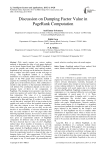
Discussion on Damping Factor Value in PageRank Computation
Статья научная
Web search engines use various ranking methods to determine the order of web pages displayed on the Search Engine Result Page (SERP). PageRank is one of the popular and widely used ranking method. PageRank of any web page can be defined as a fraction of time a random web surfer spends on that web page on average. The PageRank method is a stationary distribution of a stochastic method whose states are web pages of the Web graph. This stochastic method is acquired by combining the hyperlink matrix of the web graph and a trivial uniform process. This combination is needed to make primitive so that stationary distribution is well defined. The combination depends on the value of damping factor α∈[0,1] in the computation of PageRank. The damping factor parameter state that how much time random web surfer follow hyperlink structure than teleporting. The value of α is exceptionally empirical and in current scenario α = 0.85 is considered as suggested by Brin and Page. If we take α =0.8 then we can say that out of total time, 80% of time is taken by the random web surfer to follow the hyperlink structure and 20% time they teleport to new web pages randomly. Today web surfer gets worn out too early on the web because of non-availability of relevant information and they can easily teleport to new web pages rather than following hyperlink structure. So we have to choose some value of damping factor other than 0.85. In this paper, we have given an experimental analysis of PageRank computation for different value of the damping factor. We have observed that for value of α=0.7, PageRank method takes fewer numbers of iterations to converge than α=0.85, and for these values of α the top 25 web pages returned by PageRank method in the SERP are almost same, only some of them exchange their positions. From the experimental results it is observed that value of damping factor α=0.7 takes approximate 25-30% fewer numbers of iterations than α=0.85 to get closely identical web pages in top 25 result pages for personalized web search, selective crawling, intra-web search engine.
Бесплатно

Статья научная
This research paper study the performance of distance relays setting based analytic (AM) and artificial neural network (ANN) method for a 400 kV high voltage transmission line in Eastern Algerian transmission networks at Sonelgaz Group compensated by series Flexible AC Transmission System (FACTS) i.e. Thyristor Controlled Series Reactor (TCSR) connected at midpoint of the electrical transmission line. The facts are used for controlling transmission voltage, power flow, reactive power, and damping of power system oscillations in high power transfer levels. This paper studies the effects of TCSR insertion on the total impedance of a transmission line protected by distance relay and the modified setting zone protection in capacitive and inductive boost mode for three zones. Two different techniques have been investigated in order to prevent circuit breaker nuisance tripping to improve the performances of the distance relay protection.
Бесплатно
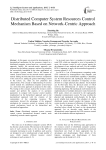
Distributed Computer System Resources Control Mechanism Based on Network-Centric Approach
Статья научная
In this paper, we present the development of a decentralized mechanism for the resources control in a distributed computer system based on a network-centric approach. Intially, the network-centric approach was proposed for the military purposes, and now its principles are successfully introduced in the other applications of the complex systems control. Due to the features of control systems based on the network-centric approach, namely adding the horizontal links between components of the same level, adding the general knowledge control in the system, etc., there are new properties and characteristics. The concept of implementing of resource control module for a distributed computer system based on a network-centric approach is proposed in this study. We, basing on this concept, realized the resource control module and perform the analysis of its operation parameters in compare with resource control modules implemented on the hierarchical approach and on the decentralized approach with the creation of the communities of the computing resources. The experiments showed the advantages of the proposed mechanism for resources control in compare with the control mechanisms based on the hierarchical and decentralized approaches.
Бесплатно
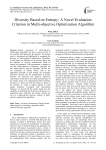
Diversity Based on Entropy: A Novel Evaluation Criterion in Multi-objective Optimization Algorithm
Статья научная
Quality assessment of Multi-objective Optimization algorithms has been a major concern in the scientific field during the last decades. The entropy metric is introduced and highlighted in computing the diversity of Multi-objective Optimization Algorithms. In this paper, the definition of the entropy metric and the approach of diversity measurement based on entropy are presented. This measurement is adopted to not only Multi-objective Evolutionary Algorithm but also Multi-objective Immune Algorithm. Besides, the key techniques of entropy metric, such as the appropriate principle of grid method, the reasonable parameter selection and the simplification of density function, are discussed and analyzed. Moreover, experimental results prove the validity and efficiency of the entropy metric. The computational effort of entropy increases at a linear rate with the number of points in the solution set, which is indeed superior to other quality indicators. Compared with Generational Distance, it is proved that the entropy metric have the capability of describing the diversity performance on a quantitative basis. Therefore, the entropy criterion can serve as a high-efficient diversity criterion of Multi-objective optimization algorithms.
Бесплатно
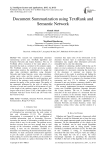
Document summarization using textrank and semantic network
Статья научная
The research has implemented document summarizing system uses TextRank algorithms and Semantic Networks and Corpus Statistics. The use of TextRank allows extraction of the main phrases of a document that used as a sentence in the summary output. The TextRank consists of several processes, namely tokenization sentence, the establishment of a graph, the edge value calculation algorithms using Semantic Networks and Corpus Statistics, vertex value calculation, sorting vertex value, and the creation of a summary. Testing has done by calculating the recall, precision, and F-Score of the summary using methods ROUGE-N to measure the quality of the system output. The quality of the summaries influenced by the style of writing, the selection of words and symbols in the document, as well as the length of the summary output of the system. The largest value of the F-Score is 10% of the length ta of the document with the F-Score 0.1635 and 150 words with the F-Score 0.1623.
Бесплатно
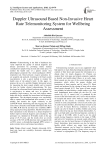
Doppler ultrasound based non-invasive heart rate telemonitoring system for wellbeing assessment
Статья научная
Telemonitoring in the field of healthcare has vastly improved the quality of clinical diagnosis and disease prevention by providing timely medical consultation to people living in rural and remote areas. To monitor the health state of a patient certain vital physiological parameter like electrocardiogram (ECG), respiration rate, blood pressure, oxygen saturation, etc. are acquired and analyzed. Listening to the heart sounds (auscultation) is also a quick method to monitor the health state of the patient’s heart. In this paper, we propose the use of a portable Doppler ultrasound sensor for measuring the heart sounds reliably and to transmit the data for further clinical telemonitoring. We have developed an ultrasound-based hardware prototype which is non-invasive in nature and easy to operate. Its portability, high accuracy, low cost, and wireless nature make this device suitable for home-based self-diagnostic applications. The developed prototype was successfully able to capture both fundamental heart sounds S1 and S2 reliably and transfer the signal wirelessly to the LabVIEW-based monitoring and data logging unit. This unit extracts clinically useful health information like heart rate (HR), R-R interval and heart rate variability (HRV) using signal processing algorithms. Health information is then transmitted via the Internet to a distant hospital for further improved clinical diagnosis and consultancy. The prototype was validated on 40 healthy males in the age group of 25-35 years, and the results show an overall accuracy of 96.74% in HR detection when compared with an ECG sensor, a photoplethysmograph (PPG) sensor, a pulse oximeter device and manual auscultation.
Бесплатно
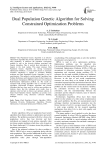
Dual Population Genetic Algorithm for Solving Constrained Optimization Problems
Статья научная
Dual Population Genetic Algorithm is an effective optimization algorithm that provides additional diversity to the main population. It addresses the premature convergence problem as well as the diversity problem associated with Genetic Algorithm. Thus it restricts their individuals to be trapped in the local optima. This paper proposes Dual Population Genetic Algorithm for solving Constrained Optimization Problems. A novel method based on maximum constrains satisfaction is applied as constrains handling technique and Dual Population Genetic Algorithm is used as meta-heuristic. This method is verified against 9 problems from Problem Definitions and Evaluation Criteria for the Congress on Evolutionary Computation 2006 Special Session on Constrained Real-Parameter Optimization problem set. The results are compared with existing algorithms such as Ant Bee Colony Algorithm, Differential Evolution Algorithm and Genetic Algorithm that have been used for solving same problem set. Analysis shows that this technique gives results close to optimum value but fails to obtain exact optimum solution. In future Dual Population Genetic Algorithm can produce more efficient solutions using alternative constrains handling technique.
Бесплатно
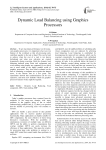
Dynamic Load Balancing using Graphics Processors
Статья научная
To get maximum performance on the many-core graphics processors, it is important to have an even balance of the workload so that all processing units contribute equally to the task at hand. This can be hard to achieve when the cost of a task is not known beforehand and when new sub-tasks are created dynamically during execution. Both the dynamic load balancing methods using Static task assignment and work stealing using deques are compared to see which one is more suited to the highly parallel world of graphics processors. They have been evaluated on the task of simulating a computer move against the human move, in the famous four in a row game. The experiments showed that synchronization can be very expensive, and those new methods which use graphics processor features wisely might be required.
Бесплатно
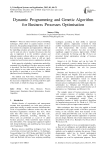
Dynamic Programming and Genetic Algorithm for Business Processes Optimisation
Статья научная
There are many business process modelling techniques, which allow to capture features of those processes, but graphical, diagrammatic models seems to be used most in companies and organizations. Although the modelling notations are more and more mature and can be used not only to visualise the process idea but also to implement it in the workflow solution and although modern software allows us to gather a lot of data for analysis purposes, there is still not much commercial used business process optimisation methods. In this paper the scheduling / optimisation method for automatic task scheduling in business processes models is described. The Petri Net model is used, but it can be easily applied to any other modelling notation, where the process is presented as a set of tasks, i.e. BPMN (Business Process Modelling Notation). The method uses Petri Nets’, business processes’ scalability and dynamic programming concept to reduce the necessary computations, by revising only those parts of the model, to which the change was applied.
Бесплатно
Статья научная
In this paper, a dynamic recurrent wavelet neural network observer and tracking control strategy is presented for a class of uncertain, nonaffine systems. In proposed scheme a dynamic recurrent wavelet network is used to design a nonlinear observer .Adaptation laws are developed for the online tuning of wavelet parameters. Based on the estimated states, a state feedback control law is derived to achieve the desired tracking performance. The stability of closed loop system and ultimate upper boundedness all closed loop signals is proven in Lyapunov sense. Effectiveness of proposed scheme is demonstrated through numerical simulation.
Бесплатно

Dynamic Vehicle Routing Problem: Solution by Ant Colony Optimization with Hybrid Immigrant Schemes
Статья научная
During past decades, several Meta-Heuristics were considered by researchers to solve Dynamic Vehicle Routing Problem.In this paper, Ant Colony Optimization integrated with Hybrid Immigrant Schemes methods are proposed for solving Dynamic Vehicle Routing Problem. Ant Colony Optimization with hybrid immigrant schemes methods namely HIACO-I, HIACO-II and HIACO-III focused on establishing the proper balance between intensification and diversification. The performance evaluation of the algorithms in which Random Immigrants and Elitism based Immigrants were hybridized in different proportions and added to Ant Colony Optimization algorithm showed that they had produced better results in many dynamic test cases generated from three Vehicle Routing Problem instances.
Бесплатно
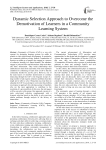
Dynamic selection approach to overcome the demotivation of learners in a community learning system
Статья научная
Community of Practice (CoP) is a very rich concept for designing learning systems for adults in relation to their professional development. In particular, for community problem solving. Indeed, Communities of Practice are made up of people who engage in a process of collective learning in a shared domain. The members engage in joint activities and discussions, help each other, and share information. They build relationships that enable them to learn from each other. The most important condition for continuing to learn from a CoP is that the community should live and be active. However, one of the main factors of members demotivation to continue interacting through the CoP is the frequent receipt of a large number of aid requests related to problems that they might not be able to solve. Thing that may lead them to abandon the CoP. In an attempt to overcome this problem, we propose an approach for selecting a group of members who are the most appropriate to contribute to the resolution of a given problem. In this way, the aid request will be sent only to this group. Our approach consists of a static rules-based selection complemented with a dynamic selection based on the ability to solve previous similar problems through analysis of the history of interactions.
Бесплатно
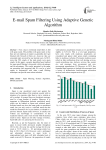
E-mail Spam Filtering Using Adaptive Genetic Algorithm
Статья научная
Now a day’s everybody email inbox is full with spam mails. The problem with spam mails is that they are not malicious in nature so generally don’t get blocked with firewall or filters etc., however, they are unwanted mails received by any internet users. In 2012, more that 50% emails of the total emails were spam emails. In this paper, a genetic algorithm based method for spam email filtering is discussed with its advantages and dis-advantages. The results presented in the paper are promising and suggested that GA can be a good option in conjunction with other e-mail filtering techniques can provide more robust solution.
Бесплатно
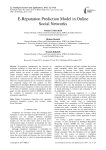
E-reputation prediction model in online social networks
Статья научная
E-reputation management has become an important challenge for firms that try to improve their notoriety across the web and more specifically in social media. Indeed, the power of online communities to impact a brand’s image is undeniable and companies need a powerful system to measure their reputation as perceived by connected society. Moreover, they need to follow its variation and forecast its evolution to anticipate any impacting change. For this purpose we have implemented an Intelligent Reputation Measuring System (IRMS) that assesses reputation in online social networks on the basis of members’ activity and popularity. In this paper, we add a predictive module to IRMS that forecasts the evolution of reputation score using influence propagation algorithms.
Бесплатно
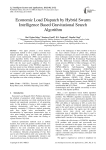
Economic Load Dispatch by Hybrid Swarm Intelligence Based Gravitational Search Algorithm
Статья научная
This paper presents a novel heuristic optimization method to solve complex economic load dispatch problem using a hybrid method based on particle swarm optimization (PSO) and gravitational search algorithm (GSA). This algorithm named as hybrid PSOGSA combines the social thinking feature in PSO with the local search capability of GSA. To analyze the performance of the PSOGSA algorithm it has been tested on four different standard test cases of different dimensions and complexity levels arising due to practical operating constraints. The obtained results are compared with recently reported methods. The comparison confirms the robustness and efficiency of the algorithm over other existing techniques.
Бесплатно
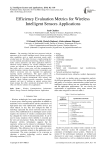
Efficiency Evaluation Metrics for Wireless Intelligent Sensors Applications
Статья научная
The metrology field has been progressed with the appearance of the wireless intelligent sensor systems providing more capabilities such as signal processing, remote multi-sensing fusion etc. This kind of devices is rapidly making their way into medical and industrial monitoring, collision avoidance, traffic control, automotive and others applications. However, numerous design challenges for wireless intelligent sensors systems are imposed to overcome the physical limitations in data traffic, such as system noise, real time communication, signal attenuation, response dynamics, power consumption, and effective conversion rates etc, especially for applications requiring specific performances. This paper analyzes the performance metrics of the mentioned sensing devices systems which stands for superior measurement, more accuracy and reliability. Study findings prescribe researchers, developers/ engineers and users to realizing an optimal sensing motes design strategy that offers operational advantages which can offer cost-effective solutions for an application.
Бесплатно

Efficient Data Clustering Algorithms: Improvements over Kmeans
Статья научная
This paper presents a new approach to overcome one of the most known disadvantages of the well-known Kmeans clustering algorithm. The problems of classical Kmeans are such as the problem of random initialization of prototypes and the requirement of predefined number of clusters in the dataset. Randomly initialized prototypes can often yield results to converge to local rather than global optimum. A better result of Kmeans may be obtained by running it many times to get satisfactory results. The proposed algorithms are based on a new novel definition of densities of data points which is based on the k-nearest neighbor method. By this definition we detect noise and outliers which affect Kmeans strongly, and obtained good initial prototypes from one run with automatic determination of K number of clusters. This algorithm is referred to as Efficient Initialization of Kmeans (EI-Kmeans). Still Kmeans algorithm used to cluster data with convex shapes, similar sizes, and densities. Thus we develop a new clustering algorithm called Efficient Data Clustering Algorithm (EDCA) that uses our new definition of densities of data points. The results show that the proposed algorithms improve the data clustering by Kmeans. EDCA is able to detect clusters with different non-convex shapes, different sizes and densities.
Бесплатно

